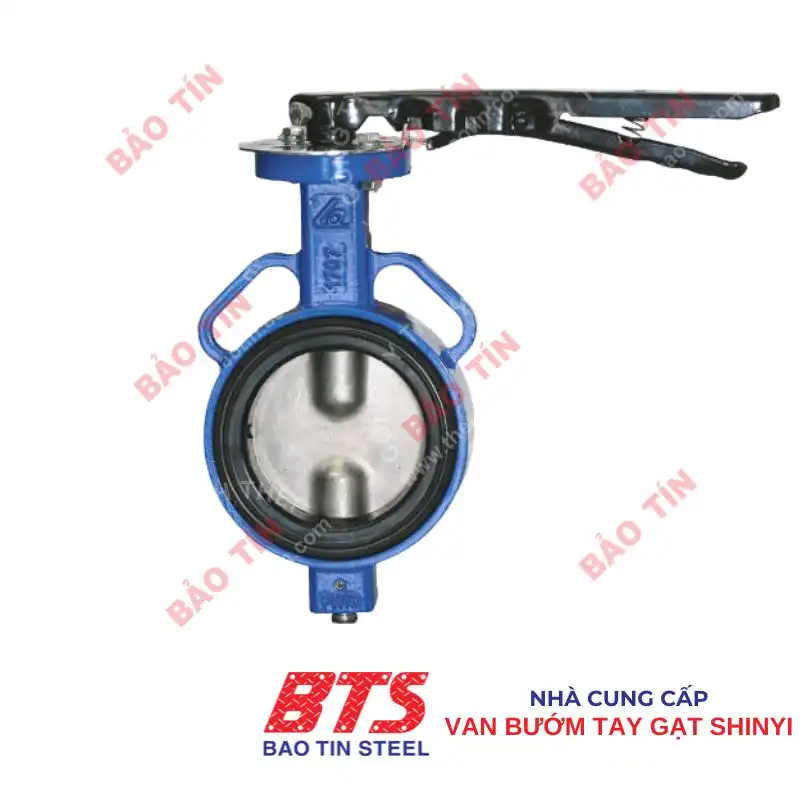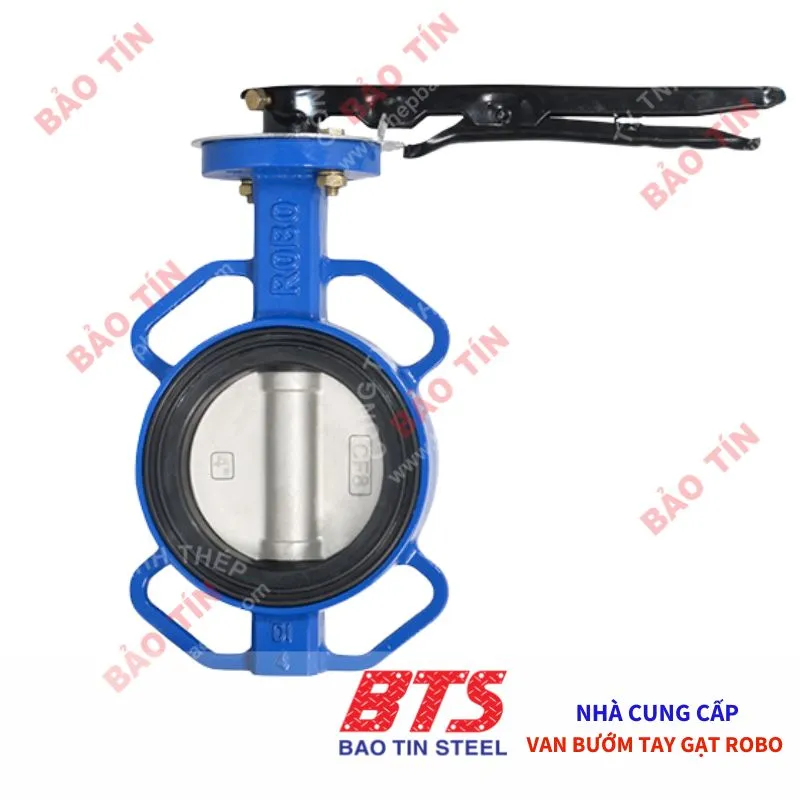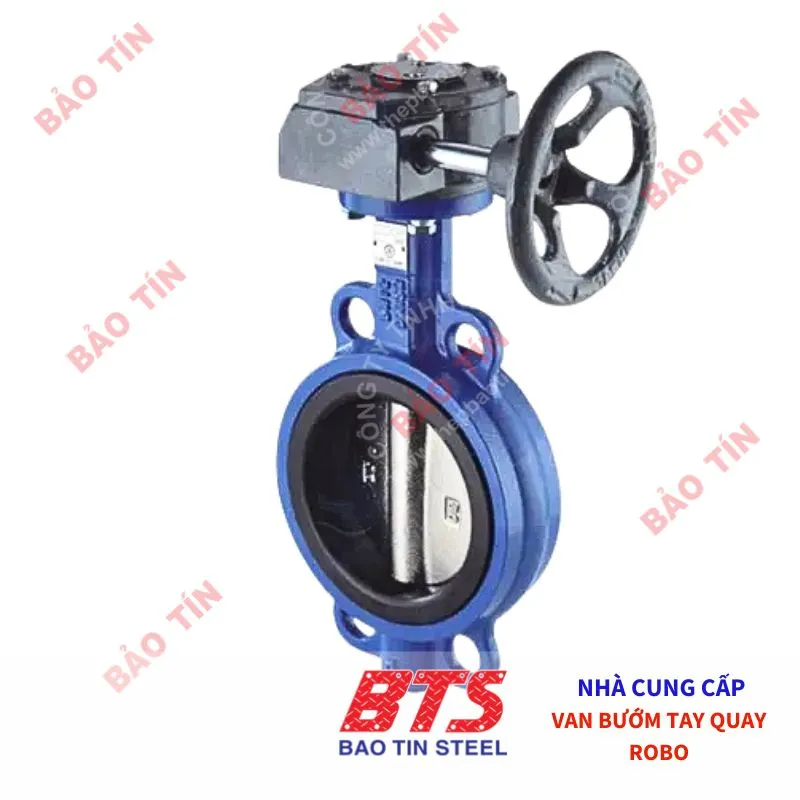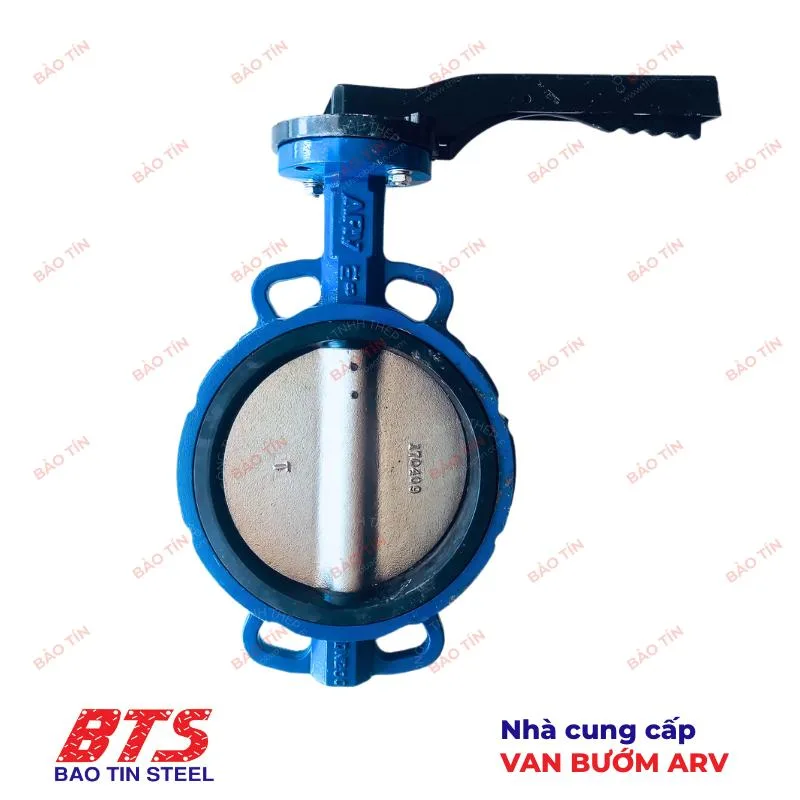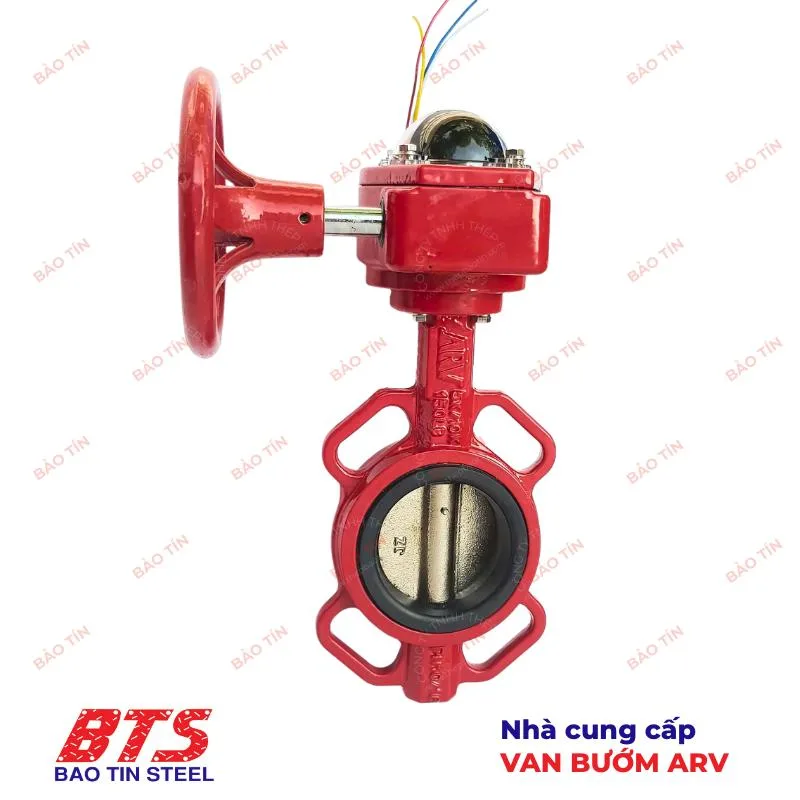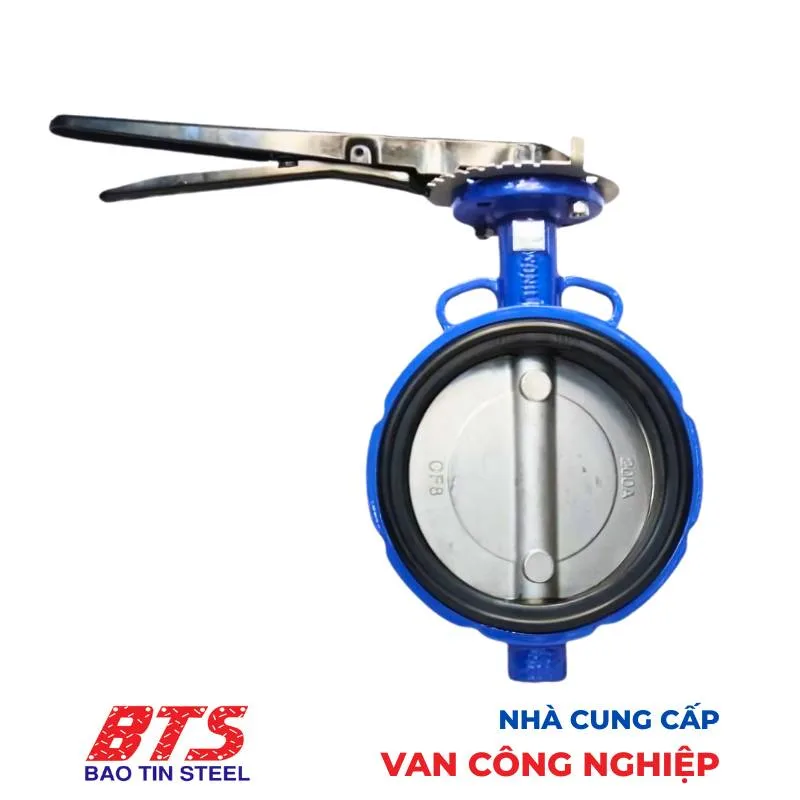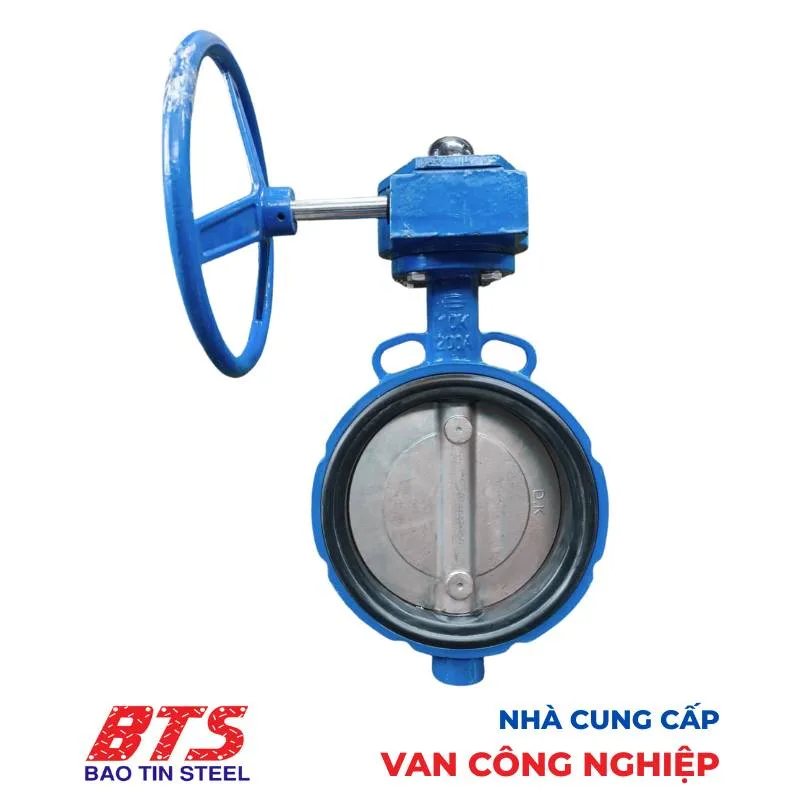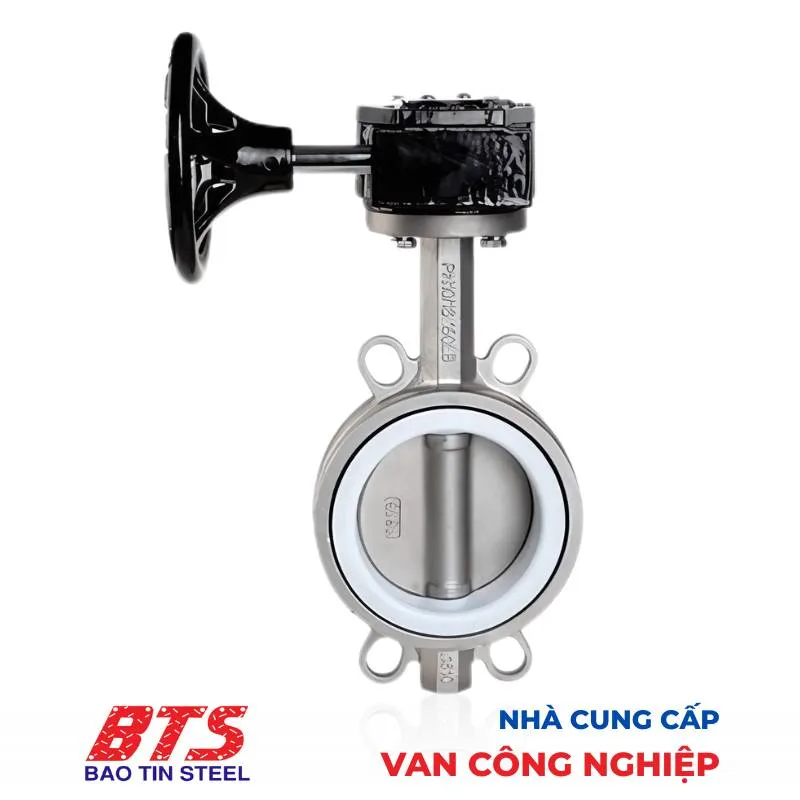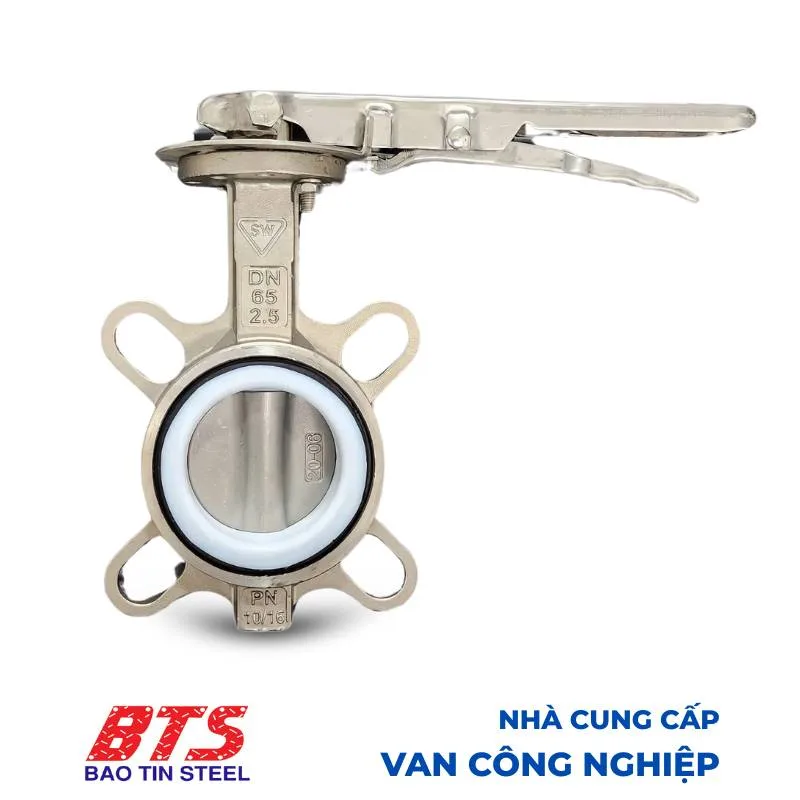Butterfly valves are widely used across various applications – from residential and industrial water supply and drainage systems to pipelines transporting oil, chemicals, and steam in factories. Their simple construction, ease of operation, and reasonable cost are key advantages that make this type of valve popular. However, the crucial point is this: not all butterfly valves are suitable for every type of medium.
Through working with thousands of customers and technical partners, the Bao Tin Steel team has frequently provided consultation in situations such as:
- Valves are corroding quickly due to the wrong material being used with aggressive chemicals.
- Seals blistering or leaking because they couldn’t withstand high temperatures or viscous oils.
- Valves opening/closing poorly or causing flow blockages due to fluids containing solid particles.
These cases highlight a critical factor — often overlooked but vital to the performance and lifespan of the entire system — which is selecting the right valve material for each specific type of fluid.
Why Is Valve Material Selection So Important?
From both a technical perspective and hands-on experience, Bảo Tín Steel has observed that a valve with incompatible construction and materials for the given fluid is prone to serious issues such as:
- Leakage or corrosion caused by chemical reactions between the valve material and the fluid.
- Reduced valve lifespan due to seal failure under excessive temperature or pressure.
- Safety risks in systems transporting oil, steam, or hazardous chemicals.
- Increased maintenance and replacement costs are required as the valve requires frequent repair or replacement.
Each type of fluid has its own specific characteristics — such as corrosiveness, viscosity, pressure, and temperature.
Therefore, selecting the right butterfly valve requires a clear understanding of both the fluid properties and the technical specifications of each valve type.
Choosing the correct valve type, with the right material, for the right working environment is not only the optimal technical solution — it’s also a smart investment that helps reduce long-term costs for the entire system.
Key Factors to Consider When Choosing a Butterfly Valve
With over a decade of experience working alongside water treatment plants, oil pipelines, chemical processing lines, and industrial boiler systems, Bảo Tín Steel has learned that choosing a butterfly valve is not simply about selecting a device to open or close flow — it’s about selecting a safe, durable, and cost-effective operational solution.
Here are the critical technical factors you need to carefully analyse before making your decision:
Type of Fluid – The #1 Factor That Cannot Be Overlooked
This is the key element that determines all subsequent decisions. Based on Bao Tín Steel’s experience, you need a clear understanding of the physical and chemical properties of the fluid that the butterfly valve will handle.
Ask yourself the following questions:
- What type of fluid is being transported? (Clean water, wastewater, oil, gasoline, acid, alkali, steam, compressed air, etc.)
- Is the fluid corrosive? To what extent? (Consider pH level, chemical concentration)
- Is it hazardous, flammable, or explosive?
- Does it contain solid particles or impurities? What is the size and hardness of those particles?
- What is the fluid’s viscosity?
Answering these questions will help you choose the correct body material, disc material, and especially the seat/seal material of the valve.
A mistake at this stage — even if the valve itself is high-quality — will lead to rapid damage or leakage.
Operating Temperature and Pressure
Each butterfly valve and its materials have specific temperature and pressure limits. Exceeding these can cause failure or leaks.
Key points to consider:
-
Minimum and maximum operating temperatures, including spikes.
-
Nominal and maximum system pressures (e.g., PN10, PN16, PN25, PN40).
Make sure the valve you choose meets or exceeds these specifications to ensure safe and stable system operation.
Valve Body Material
The valve body supports the load and contacts the fluid indirectly. Choose materials based on environment and strength needs:
-
Cast Iron / Ductile Iron: Economical for clean water, mild wastewater, and compressed air at moderate conditions. Ductile iron is stronger than grey cast iron.
-
Carbon Steel (WCB): Handles higher pressure and temperature, ideal for oil, gas, and steam systems.
-
Stainless Steel (SS304, SS316, SS316L): Excellent corrosion resistance for chemicals, food, pharma, and seawater. SS316L offers superior corrosion resistance.
-
Plastic (PVC, CPVC, UPVC): Great chemical resistance for corrosive fluids at low temperature and pressure but limited in extreme conditions.

Disc Material
The disc is the component that directly contacts and regulates the flow of the fluid, so its material must be considered even more carefully than the valve body:
- Epoxy-coated Cast Iron:
An economical choice, suitable for regular water use. - Stainless Steel 304/316:
Corrosion-resistant, ideal for seawater, oil, and mild chemicals. - Titanium, Hastelloy:
Designed for strong chemicals and harsh environments.
To ensure durability and performance, it is recommended to choose a stainless steel disc even for clean water applications, especially in projects requiring high hygiene standards or where a mild corrosion risk exists.
Seat/Liner Material
The seat or liner is the part that directly and continuously contacts the fluid:
- EPDM:
Good temperature resistance and high elasticity. Suitable for water, wastewater, gases, some dilute acids, and alcohol. - NBR (Buna-N):
Excellent resistance to oils, oil-based solvents, and water. Commonly used in oil & gas and fuel applications. - PTFE (Teflon):
Outstanding chemical resistance against most acids, alkalis, solvents, and can withstand relatively high temperatures. This is the top choice for strong chemical applications. - Viton:
Better resistance than NBR and EPDM to high temperatures, strong chemicals, oils, and fuels. Suitable for hot oil and special chemical applications. - Metal Seat:
Used for very high temperature and pressure applications (such as superheated steam) or when the fluid contains solid particles that cause abrasion to soft seats. However, metal seats do not provide as tight a seal as soft seats.

Connection Types with the Pipeline
Depending on the system and installation location, you should choose from:
- Wafer:
Compact, sandwiched between two flanges, is the most common type. - Lug:
Has bolt holes on the lugs, allowing easy removal of one side without disturbing the other. - Flanged:
Valve with integral flanges, sturdy and used in high-pressure systems. - Butt Weld:
Directly welded connection, suitable for fixed systems where disassembly is not required.
Standards and Certifications
Technical standards help ensure safety, quality, and interchangeability:
- API, ANSI:
American standards are commonly used in oil & gas and heavy industry. - JIS:
Japanese standards are popular in HVAC and water supply/drainage systems. - ISO, DIN:
European standards are used in modern industrial applications.
At Bao Tín Steel, genuine butterfly valves come with full CO-CQ certificates, clear warranties, and pressure testing before shipment upon customer request.
Selecting Butterfly Valves for Specific Types of Fluids
Below are detailed guidelines—drawn from the practical experience of Bảo Tín Steel’s expert consulting team.
Butterfly Valves for Water (clean water, wastewater, cooling water, etc.)
Technical requirements:
Corrosion resistance, ability to withstand water pressure, and, importantly, reasonable cost. For clean water, material selection must also ensure hygiene standards are met.

Recommended Materials:
- Body: Grey cast iron or ductile iron (epoxy-coated).
- Disc: Epoxy-coated cast iron or stainless steel 304/316 (used for mildly corrosive wastewater).
- Seat: EPDM (most common due to high sealing ability and good elasticity), or NBR if the fluid contains oil.
Suggestions for suitable butterfly valve lines
Practical Notes:
- For seawater or chemically contaminated wastewater, it is recommended to use a stainless steel body or corrosion-resistant disc.
- Avoid using ordinary cast iron without an epoxy coating, as it is prone to rust, especially in wastewater applications.
Butterfly Valves for Oil (hydraulic oil, fuel, lubricants, etc.)
Technical requirements:
Resistance to oil, corrosion resistance against oil components, and the ability to withstand the operating temperature of the oil.

Recommended Materials:
- Body: Epoxy-coated cast iron, carbon steel (for high temperatures).
- Disc: Stainless steel 304 or 316.
- Seat: NBR (specifically designed for oil), Viton for high-temperature oil or special chemical properties.
Suggestions for suitable butterfly valve lines
Practical Notes:
- Do not use EPDM seats for oil systems — they tend to swell and blister, causing leaks after a short period.
- When operating with oil temperatures above 100°C, consider choosing body and disc materials with better heat resistance (carbon steel or stainless steel).
Butterfly Valves for Chemicals (acids, alkalis, solvents, cleaning agents, etc.)
Technical requirements:
Absolute corrosion resistance against chemicals, and the ability to withstand the temperature and concentration of the chemicals.

Recommended Materials:
For mild chemicals with low concentration:
- Body: PVC, UPVC, or cast iron coated with PTFE.
- Disc: Stainless steel 316L, or plastic-coated (PTFE/FEP).
- Seat: PTFE (Teflon), or Viton if mild heat resistance is required.
For strong chemicals with high concentration:
- Body: Stainless steel 316, Super Duplex, Hastelloy, or fully PTFE-lined butterfly valves.
- Disc: PTFE/PFA coated or Titanium.
- Seat: Virgin PTFE or TFM — highly resistant to permeation and deformation.
Suggestions for suitable butterfly valve lines
Butterfly Valves for Steam (saturated steam, superheated steam, etc.)
Technical requirements:
Ability to withstand high temperature and pressure, and resistance to corrosion caused by condensation.

Recommended Materials:
-
Body: Carbon steel (WCB) or stainless steel.
-
Disc: Stainless steel 304/316 – stable at high temperatures.
-
Seat:
-
Metal Seat: Ideal for steam temperatures above 150°C.
-
PTFE or Viton: Suitable only for medium-temperature steam (<120°C).
-
For steam applications, you can also consider Triple Offset or Cryogenic/High Temp butterfly valves from brands like DHC.
Practical Notes:
-
Butterfly valves are not the optimal choice for superheated steam above 180°C. In many cases, globe valves or metal ball valves are more suitable.
-
However, for saturated steam or medium-temperature steam systems (80–130°C), butterfly valves remain an economical and effective option.
Conclusion
Bảo Tín Steel has accompanied you on a deep dive into the importance of selecting the right butterfly valve and the key factors to consider. From the valve body material, disc, and sealing seat to temperature, pressure specifications, and connection types, every detail contributes to the system’s performance and longevity.
Here’s a summary of the key points you need to remember:
- Different fluids → different valve construction and materials.
- The sealing seat is the most vulnerable part if the wrong material is chosen.
- Butterfly valves designed for water cannot be used for oil or corrosive chemicals.
- Pressure and temperature affect not only the valve’s lifespan but also operational safety.
- Sometimes, choosing a slightly more expensive valve that fits perfectly can save maintenance, replacement, and downtime costs in the long run.
And when selecting a valve:
- Don’t choose a valve based solely on price. Consider the Life Cycle Cost, which includes the purchase price, operating costs, maintenance, and replacement expenses.
- Always refer to the manufacturer’s technical documentation, as each catalogue is a valuable source of information on operational limits and materials for each valve model. Don’t overlook them!
- Don’t hesitate to seek expert advice from professionals. This will help you make the most accurate choice and ensure your system operates at maximum efficiency.
If you need expert advice on selecting the right butterfly valve for your system,
Leave a comment, contact our hotline at 0932 059 176, or send your consultation request via email to kinhdoanh@thepbaotin.com – Bảo Tín Steel’s consulting specialists will get in touch to support you thoroughly!


 Tiếng Việt
Tiếng Việt ភាសាខ្មែរ
ភាសាខ្មែរ
